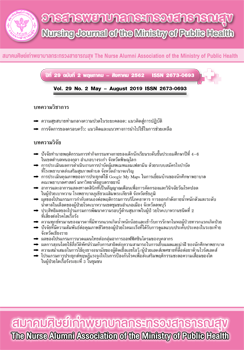A Study of Consistent Condom Use Among Males Living With HIV Drug Resistance A Study of Consistent Condom Use Among Males Living With HIV Drug Resistance
Main Article Content
Abstract
The present study was based on a descriptive correlational research design aimed at studying the correlations between consistent condom use and related factors using Theory of Planned Behavior among primary and secondary males with HIV drug resistance (HIVDR). The subjects were purposively sampled 55 subjects. Data were collected using questionnaires, including personal data, illness and treatment, sexual intercourse in three months and in the past, HIV infection, condom use behaviors and correlations between consistent condom use and related factors. The findings of the study revealed that 72.7% of the subjects always used condoms during sex. Concerning the correlations between consistent condom use and related factors, intention to use condom was correlated with consistent condom use with statistical significance (r=.534, p<.001) and perceived behavioral control of condom use was correlated with consistent condom use with statistical significance (r=.402, p=.002). According to the findings, campaigns should encourage males with HIVDR in their intention to use condom during sex with a spouse/partner by raising their awareness of the importance of condom use every sexual intercourse. Support for males with HIVDR who have perceived behavioral control of condom use when there is a need to use condoms to prevent the spread of HIVDR to spouses/partners, prevent them from getting more infections.
Article Details
บทความและรายงานวิจัยในวารสารพยาบาลกระทรวงสาธารณสุข เป็นความคิดเห็นของ ผู้เขียน มิใช่ของคณะผู้จัดทำ และมิใช่ความรับผิดชอบของสมาคมศิษย์เก่าพยาบาลกระทรวงสาธารณสุข ซึ่งสามารถนำไปอ้างอิงได้
References
2. Bureau of Aids, TB and STIs. DDC WATCH [internet]. 2014[cited 2015 May]. Available from:file:///C:/Users/Sony/Downloads/DDCWatch-AIDs_1434052790.pdf
3. Sungkanuparph S. HIV drug resistance: pathogenesis of HIV drug resistance. Bangkok: Mohchoaban; 2008. (in Thai)
4. Kiertiburanakul S. HIV drug resistance: primary HIV drug resistance. Bangkok: Mohchoaban; 2008. (in Thai)
5. Joint United Nations Program on HIV/AIDS(UNAIDS) & Word Health Organization (WHO). WHO AIDS statistics- presentation transcript [internet]. 2009[cited 2012 July]. Available from: http://www. slideshare.net/thebrightestman/2009-who-aids-tatistics?src=related_normal&rel=8377394
6. Chantratita W. Maximize the effectiveness of HIV-1 treatment by using molecular techniques, bioinformatics, and pharmacogenomics. Bangkok: Graphichut; 2007. (in Thai)
7. Promsorn C, Termvises P, Ramgomut A, Chumpathat N. The unsafe sexual disease behavior on condom useof the HIV/AIDS patients at the Bamrasnaradura infection institute. International conference AIDS; 2004. abstract no. D12337.
8. Visudtibhan P.J. Predictors of condom use among HIV-infected patients/AIDS with their couples. Ramathibodi Nursing Journal [Internet]. 26 Oct. 2015 [cited 2017 May];21(1):69-1. Available from: https://www.tci-thaijo.org/index.php/RNJ/article/view/23009
9. Rujkorakarn D, Kownaklai J, Khamenkhan K, Meena P, Jandeekrayom S, Piyasuwan S, et al. Overviews on sexual intercourse of HIV infected people taking anti-retroviral drugs: duty or happiness. Journal of Nursing and Health Care.2011; 29(1): 12-21.
10. Rojanawiwat A, Ariyoshi K, Pathipvanich P, Srisawat J, Auwanit W, Sawanpanyalert P. Study of risk factors associated with the HIV-1 transmission among HIV-1 affected couples in Northern Thailand. International conference AIDS;2004. abstract no. WePeA5663.
11. Hayee F, Waeteh S. Health self care for HIV transmission prevention HIV client and AIDS patients in three Southern Border Provinces of Thailand. Princess of Naradhiwas University Journal.2014;6(3):1-12.
12. Ajzen I. The theory of planned behavior. Organizational Behavior and Human Decision Process. 1991;50: 179-211.
13. Albarracin D, Fishbein M, Johnson BT, Muellerleile PA. Theories of reasoned action and planned behaviors as models of condom use: A meta-analysis. Psychological Bulletin. 2001;127:142-161.
14. Prasartwanakit A, Songwathana P, Phetcharat B. Sexual beliefs and patterns among Thai adolescents and youths in educational institutions in Songkhla Province. Songklanagarind Medical Journal.2009;27(5): 369-380.
15. Janepanish P, Dancy BL, Park C. Consistence condom use among Thai young adult males: an application of the theory of planned behavior. Aids Care.2011;23(4): 460-466.
16. Janepanish P, Masuthon S. Predictors of condom use among four groups of young Thai adult males
in Bangkok. Journal of Nursing Science Chulalongkorn University.2014; 26(1): 11-24.
17. Cohen L, Manion, L. Research Methods in Education, 3thed. London: Routledge;1989.
18. Rojpalakorn P, Ruecha Y. Statistics for nursing research and using the SPSS for windows. Bangkok: Mahidol University; 2010. (in Thai)
19. Bureau of Epidemiology Department of Disease Control Ministry of Public Health. AIDS Report[internet].2015[cited 2017 May]. Available from: http://www.boe.moph.go.th/aids/download.php
20. Tangvoraphonkchai K, Sungkanuparph S. The incidence and risk factors of virologic failure in HIV–infected patients receiving the first regimen of antiretroviral therapy. Journal of Infectious Diseases and Antimicrobial Agents.2011; 28(3):161-68.
21. Medhajirapath S. Antiretroviral drug resistance among HIV-l-lnfected patients: A retrospective study. Medical Journal of Srisaket Surin Buriram Hospitals.2012;27(2):191-203.
22. Thai Redcross AIDS Research Center. Articles[internet]. 2012[cited 2012 March]. Available from: http://th.trcarc.org/images/Article2.pdf.
23. Ohata P.J., Avihingsanon A, Ubolyam S, Putcharoen O, Stephen J, Volnysanne A, et al. Updates on HIV treatment and prevention. In The 18th Bangkok International Symposium on HIV Medicine. Asia’s HIV symposium. 2016;249-252.
24. Khaowdang P. factors effect to antiretroviral resistance among peopleliving with hiv/aids at “niranam clinic” phayao hospital phayao province. [thesis]. Phayao: University of Phayao; 2012.
25. Bachanas P, Medley A, Pals S, Kidder D, Antelman G, Benech I, et al. Disclosure, knowledge of partner status, and condom use among HIV-positive patients attending clinical care in Tanzania, Kenya, and Namibia. AIDS Patient Care & STDS. 2013;27(7): 425-435.

